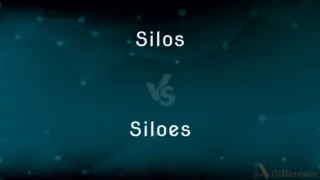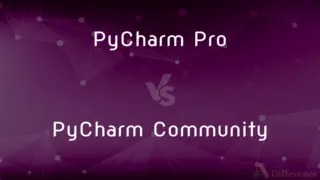Dicot Root vs. Monocot Root — What's the Difference?
By Tayyaba Rehman — Published on December 20, 2023
Dicot roots have two cotyledons, vascular bundles in a ring, and show secondary growth. Monocot roots have one cotyledon, scattered vascular bundles, and lack secondary growth.

Difference Between Dicot Root and Monocot Root
Table of Contents
ADVERTISEMENT
Key Differences
Dicot roots are characteristic of plants that sprout two embryonic leaves or cotyledons during their initial growth. Monocot roots are found in plants that produce only one cotyledon. The structure of dicot roots is marked by the presence of vascular bundles, which are organized in a circular pattern. In contrast, monocot roots display these vascular bundles scattered throughout the root.
A significant feature of dicot roots is their ability to exhibit secondary growth, giving them the capability to become thicker over time. Monocot roots, on the other hand, don't typically show this secondary growth. This means that while dicot roots can expand in diameter, monocot roots maintain a relatively consistent width.
Lastly, when it comes to the type of plants these roots support, dicot roots are typically associated with a broader range of plant species, while monocot roots are limited to plants like grasses, lilies, and orchids.
Comparison Chart
Number of Cotyledons
Two cotyledons
One cotyledon
Vascular Bundle Arrangement
Arranged in a ring
Scattered throughout the root
ADVERTISEMENT
Secondary Growth
Exhibits secondary growth
Doesn't exhibit secondary growth
Examples
Beans, sunflowers
Grasses, lilies
Pith Presence
May have a small or absent pith
Pith is generally large and present
Compare with Definitions
Dicot Root
Contains vascular bundles arranged in a ring.
Upon examining the cross-section, the dicot root revealed a ringed vascular pattern.
Monocot Root
Lacks secondary growth, maintaining a consistent width.
The bamboo's monocot root does not thicken with age.
Dicot Root
Exhibits secondary growth allowing it to thicken.
Over time, the dicot root of the oak thickened significantly.
Monocot Root
Generally has a large, central pith.
The large pith at the center of the cross-section revealed it to be a monocot root.
Dicot Root
May have a small or absent pith.
The dicot root of the bean plant showed a minuscule pith.
Monocot Root
Characteristic of plants like grasses and lilies.
Orchids, with their unique flowers, rely on a monocot root system.
Dicot Root
A root type of plants with two embryonic leaves.
Sunflowers possess a dicot root system.
Monocot Root
A root type found in plants with a single embryonic leaf.
The grass in my yard has a monocot root system.
Dicot Root
Characteristic of broad-leafed plants.
Maple trees, with their broad leaves, have a dicot root system.
Monocot Root
Features scattered vascular bundles.
The scattered vascular pattern in the cross-section indicates a monocot root.
Common Curiosities
What defines a monocot root?
Monocot roots possess one cotyledon, scattered vascular bundles, and lack secondary growth.
Can monocot roots show secondary growth?
No, monocot roots typically don't exhibit secondary growth.
What are the key characteristics of a dicot root?
Dicot roots have two cotyledons, vascular bundles in a ring, and show secondary growth.
Do dicot roots thicken over time?
Yes, dicot roots exhibit secondary growth allowing them to become thicker.
What types of plants possess monocot roots?
Grasses, lilies, and orchids are examples of plants with monocot roots.
Are dicot roots common in all plants?
No, dicot roots are specific to dicotyledonous plants.
Which plants typically have dicot roots?
Broad-leafed plants like beans, sunflowers, and oaks typically have dicot roots.
How are the vascular bundles arranged in a dicot root?
In dicot roots, vascular bundles are arranged in a ring.
Is secondary growth exclusive to dicot roots?
Typically, yes. Dicot roots show secondary growth, whereas monocot roots don't.
Which root type has a prominent pith, dicot or monocot?
Monocot roots generally have a large, central pith.
Why is understanding the difference between dicot and monocot roots important?
Differentiating between dicot and monocot roots aids in plant classification, understanding growth patterns, and agricultural practices.
How are vascular bundles in a monocot root organized?
Monocot roots have vascular bundles scattered throughout the root.
Are grasses associated with monocot or dicot roots?
Grasses have monocot roots.
Can a plant have both dicot and monocot roots?
No, a plant will either have dicot roots or monocot roots based on its classification.
How can I visually differentiate between dicot and monocot roots?
Examining a cross-section, dicot roots have a ringed vascular pattern, while monocot roots have scattered bundles.
Share Your Discovery

Previous Comparison
Lymphatic System vs. Immune System
Next Comparison
Emphasis vs. EmphasizeAuthor Spotlight
Written by
Tayyaba RehmanTayyaba Rehman is a distinguished writer, currently serving as a primary contributor to askdifference.com. As a researcher in semantics and etymology, Tayyaba's passion for the complexity of languages and their distinctions has found a perfect home on the platform. Tayyaba delves into the intricacies of language, distinguishing between commonly confused words and phrases, thereby providing clarity for readers worldwide.













































